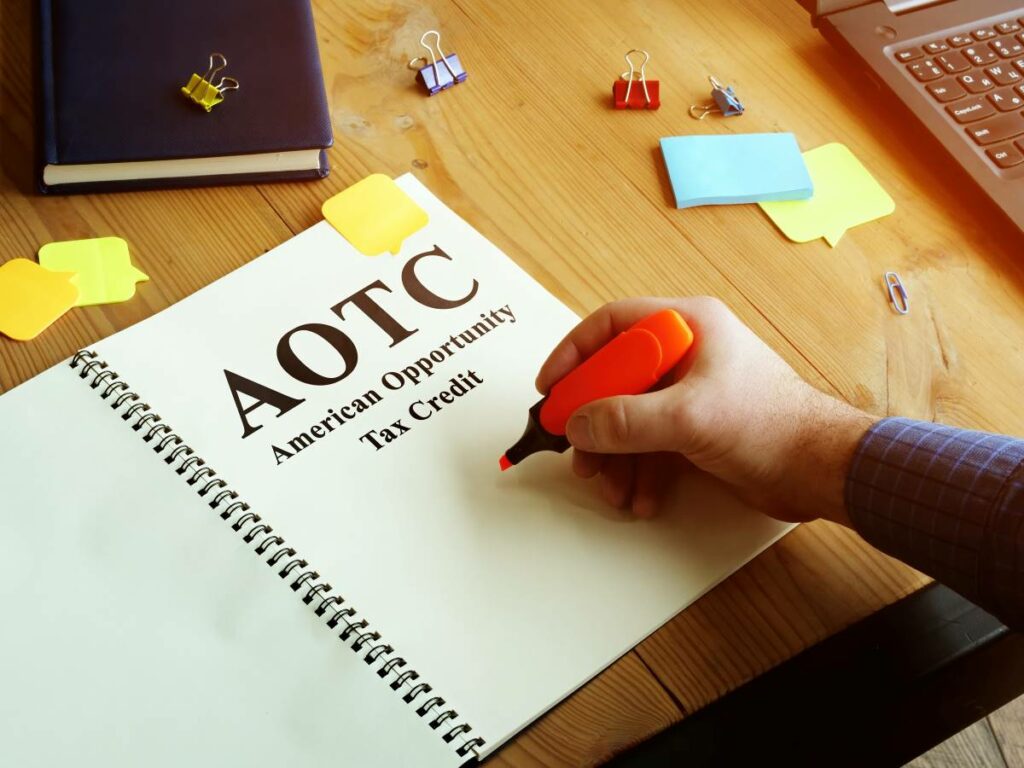Education in the US is expensive, especially in colleges and other tertiary institutions. You need sufficient finances to foot your tuition, accommodation, feeding, and other expenses while studying. This is particularly a problem for students from taxpaying, low-income households.
Fortunately, some benefits and programs can help offset their educational expenses. One such program is the American Opportunity Tax Credit (AOTC). This article provides an overview of this tax credit, its eligibility requirements, how many credits can be claimed, and how to claim it.

What Is the American Opportunity Tax Credit?
The American Opportunity Tax Credit (AOTC) provides qualifying college students or their parents with annual credits to offset the costs of attending tertiary education. It was introduced as part of the American Recovery and Reinvestment Act of 2009 and has since been available for eligible taxpayers pursuing higher learning.
Difference between AOTC and FAFSA
The American Opportunity Tax Credit (AOTC) and the Free Application for Federal Student Aid (FAFSA) differ in various ways. While the former helps eligible people to offset their educational costs, the latter is an application that determines a student’s eligibility for financial aid such as loans, grants, and work-study programs.
More so, while the AOTC is claimed on federal income tax, FAFSA is submitted and approved by the Department of Education.
AOTC vs. Lifetime Learning Credit
The AOTC differs from the Lifetime Learning Credit (LLC) available to eligible persons. While the AOTC provides $2,500 per tax year, the LLC provides $2,000 per tax return.
However, the LLC can be claimed for unlimited years, while the AOTC is only limited to the first four years of learning. The LLC is designed for students who have maxed out their eligibility (after 4 years) for the AOTC and still have educational expenses to deduct from their federal income tax.
You can also read, “Parent PLUS Loans: How To Secure Financial Aid for Your Child’s Education.”
Benefits of the AOTC
Some of the benefits of this tax credit include the following:
- The credit is partially refundable, which means that qualifying individuals can receive up to $1,000 in tax refunds, even if they do not owe any federal income taxes.
- The credit provides up to $2,500 to offset the expenses of higher education, such as fees, course materials, and tuition.
- The credit is available to a wide selection of qualifying taxpayers.
How Much is the AOTC?
The American Opportunity Tax Credit allows you to claim up to $2,500 in educational expenses each tax year. However, it is important to remember that this credit cannot be claimed for more than four years in higher learning.
Who Is Eligible for AOTC?
To become eligible for the tax credit, you should meet the following requirements:
- You are a student currently pursuing a degree from a college.
- You are enrolled in at least one academic semester during the applicable tax year.
- You have not claimed the credit before.
- You must have a valid taxpayer identification number (TIN) before the due date of filing your tax return. TIN is either your Social Security Number (SNN), Individual Taxpayer Identification Number (ITIN), or an Adoption Taxpayer Identification Number (ATIN).
- You do not have a felony drug conviction at the end of the tax year.
- You want to claim the credit to offset the costs of books, supplies, equipment, and fees.
- Your modified adjusted gross income (MAGI) is below the required income limits. You must have a MAGI of $80,000 or less if you’re a single filer. However, couples must have a MAGI of $180,000.
How to Claim the Credit?
To claim the credit, you should perform the following actions:
- Refer to IRS Form 1040 – your income tax filing document. Fill in the required information on page 1, including your income and deductions.
- In Publication 970, enter your AGI into the “MAGI for the American Opportunity Tax Credit” worksheet. You can subtract your foreign-earned income, foreign housing deductions, or income from Puerto Rico and American Samoa. You can use Form 1098-T (Tuition Statement) received from your school as a guide.
- Find Part III of Form 8863 (Education Credits) and enter the total of qualified expenses, including tuition, course fees, supplies, and textbooks. Calculate the amount of your credit and transfer the information to Part I of that form.
- Part I of Form 8863 determines your eligibility based on income. It typically uses the 40% rule to determine your refundable credit amount. You can then enter your refundable and nonrefundable credit separately on Form 1040.
- Attach these forms and submit them on your tax return.
Documentation Needed To File AOTC
You will need to provide the following information to file AOTC:
- Record of expenses
- Your tax return
- Eligibility information, such as being enrolled in an academic program
- Tax Forms 1098-T and 8863
Processing Time for Receiving AOTC
The processing time for receiving AOTC depends on a couple of factors. However, it will be processed alongside your federal income tax return, and other credits or deductions claimed. The IRS typically processes this within 21 days for electronic returns, while paper returns can take up to 6 weeks.
To facilitate the process, it is recommended to provide accurate information on your Form 8863 and 1098-T.
What if Your Application Gets Declined?
You will receive a denial notice or letter from the IRS if your application to claim the AOTC gets declined. The letter will explain the reason for the disapproval, such as ineligibility or incorrect or missing information on your tax return or Form 8863.
You can appeal the decision if you believe it was made in error. You will need to provide additional information to support your claim, with a letter explaining why you believe it was a mistake on their end.
You are expected to file your appeal within 30 days of the denial notice.
A Helping Hand for Education
The American Opportunity Tax Credit (AOTC) can assist qualifying students looking to offset their educational expenses. With a tax credit of up to $2,500, you can get the financial assistance you deserve to pay tuition, books, supplies, and other fees.
If you have any further queries, we suggest you seek professional advice from an expert tax advisor or consult the resources available on the IRS website.





